Central Park New York
Introduction
While not a building, Central Park is undeniably one of the most famous and enduring landmarks in American history. Located in the heart of Manhattan, this massive green space has shaped the urban identity of New York City and served as a model for city parks across the world. As part of our series on famous American buildings and landmarks, Central Park earns its place for its historic significance, thoughtful design, and cultural influence.
An urban park in Manhattan, New York, Central Park is located between the Upper East Side and the Upper West Side of the locality. It is roughly bounded on one side by Fifth Avenue.
It is a famous tourist spot and the most visited park in the entire United States of America. An estimated 37- 38 million visitors arrive here annually. It is also a common location for shooting (films).
Table of Contents

Central Park New York Official Site
History
The Park was first approved in as far back as 1873. It covered 778 acres of land back then. In 1857, the famed duo – architect Frederick Law Olmsted and designer Calvert Vaux – won a design competition to construct the park.

They called their architectural plans the ‘Greensward Plan’. That same year, construction began on the land and the park’s first few (completed) areas were finally opened to the general public one year later, in 1858.
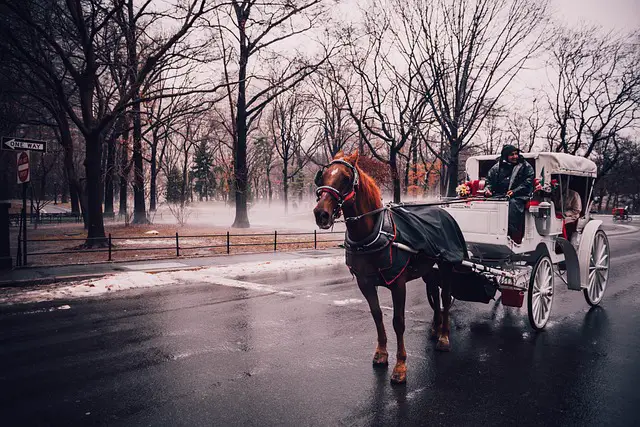
Additional land for the park’s expansion was later purchased in 1859. Construction was finally completed in 1876. Today, Central Park covers an expanse of 843 acres and is the fifth-largest park in New York City.
The park was designated a National Historical Landmark site in 1963. It was also declared a New York City scenic landmark in 1974.
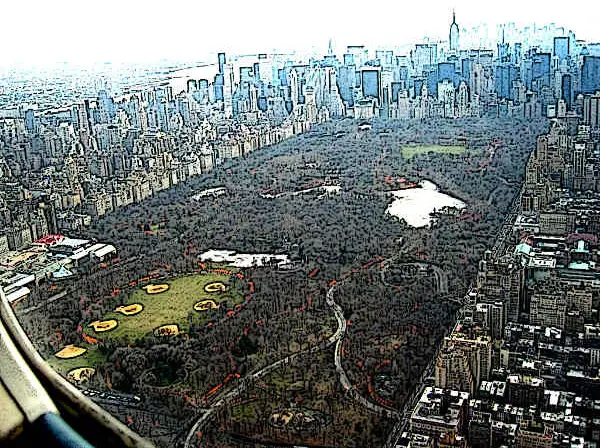
Attractions
The park is home to a wide range of attractions. These include the Ramble and Lake, a 38-acre woodland, and a 20-acre serpentine lake. The Central Park Zoo sprawls over 6.5 acres and is home to stunning exhibits.
The Jacqueline Kennedy Onassis Reservoir stretches over 106 acres and is one of the most scenic areas of the park. Other park attractions include the Delacorte Theatre, the Wollman Rink, the North Meadow Recreation Center, and the Central Park Carousel.

Management and Maintenance
While it is owned by the New York City Department of Parks and Recreation (NYC Parks), it is managed by the Central Park Conservancy – and has been since 1988.
The Central Park Conservancy efficiently manages the park under a contract with the municipal government in a public-private partnership.
The Conservancy is a non-profit organization. It contributes to 75 percent of the park’s $65 million annual budget. It is also responsible for the park’s basic care and maintenance.

Flora and Fauna
Central Park is famous for its biodiversity. It is home to species of both flora and fauna. As of 2011, the park had more than 20,000 trees. Over four million trees, shrubs, and plants representing approximately 1,500 species have been planted or imported to the park.
The Central Park Conservancy regularly maintains the park’s flora. The organization efficiently allocates gardeners to one of the 49 “zones” specifically for maintenance purposes.
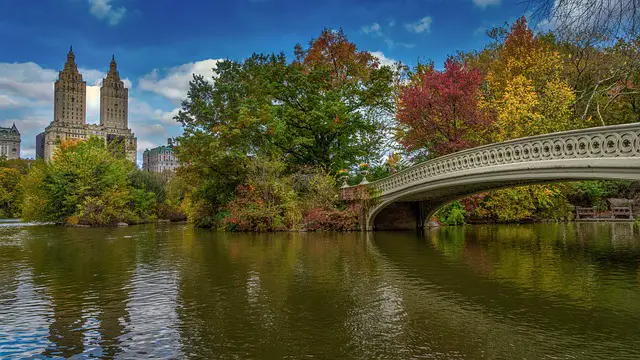
Historical Tree Clusters
Additionally, the park is home to several historical tree clusters. These clusters are steeped in the culture and are synonymous with New York itself. One of the most notable tree clusters at the park is a group of 4 American Elms. In addition, the park is also home to a grove of American Elm trees.
The American Elms found in Central Park are the largest surviving group of this variety in the wider geographical area. Other notable tree clusters found at the park include Yoshino Cherry trees situated near the Jacqueline Kennedy Onassis Reservoir and a historic Black Tupelo tree.

Bird Species found at the park
The park is also frequented by various species of birds. During their spring and fall migration on the Atlantic Flyway ( which is a major north-south flyaway from migratory birds in Northern America).
Various different bird species fly through Central Park on their way to and from different locations across the United States of America. However, the park certainly has a much smaller bird population (in comparison) to Van Cortlandt Park.
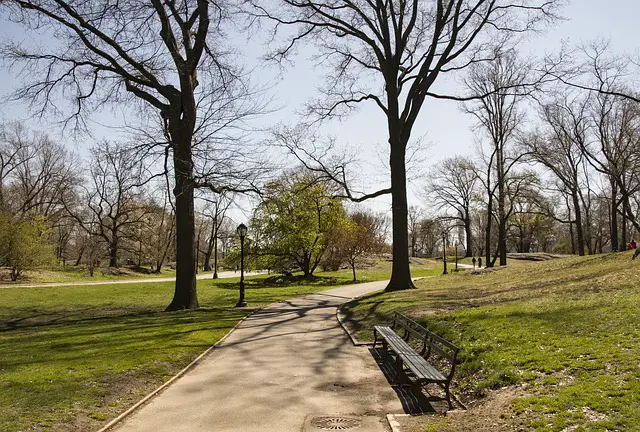
Documents bird at Central Park
More than 303 different species of birds have been documented in Central Park, ever since the first official records were published in 1886. August G. Paine Jr. and Lewis B. Woodruff were the first to publish their findings in Forest and Stream magazine that year.
An estimated 200 different types of bird species are discovered every season.
Somewhere between 1890-1891, Eugene Schieffelin released his findings of more than 100 Starlings across the length and breadth of Central Park. Some of the more famous birds include a male red-tailed hawk called Pale Male.

Mammal Species at Central Park
Aside from birds, Central Park is home to about ten different species of mammals. These include bats, raccoons, Eastern Grey squirrels, and opossums. While chipmunks are not a common sight, they, too, inhabit the park’s boundaries.

Nearly 223 invertebrate species also reside inside Central Park. One such species is Nannarrup hoffmani, a centipede species discovered in 2002. It is the smallest centipede ever to be discovered anywhere in the world.
Other species living inside Central Park are turtles, fish, and the Asian long-horned beetle. The latter is an invasive species that has infected many species of trees in Long Island and Manhattan.
Most of the turtles in the park live in Turtle Pond. Many of them were former pets that were eventually released for them to be able to live a wild, free life.

Popular Landmarks
Central Park is dotted with various landmarks. Some of the most popular landmarks include the following
Columbus Circle
A circular plaza at the southwestern corner of the park. Built-in the 1860s, its largest feature is the column of Christopher Columbus standing in the center. The column was erected in 1892.
Grand Army Plaza
A square plaza in the southeastern corner. Completed in 1916, it contains the famed Pulitzer Fountain.
Duke Ellington Circle
A circular plaza in the northeastern corner of the park, it contains the memorial of the Duke of Ellington and was dedicated in 1997.
Frederick Douglass Circle
A circular plaza in the northwestern corner, it contains the memorial of Frederick Douglass and was dedicated in 2010.
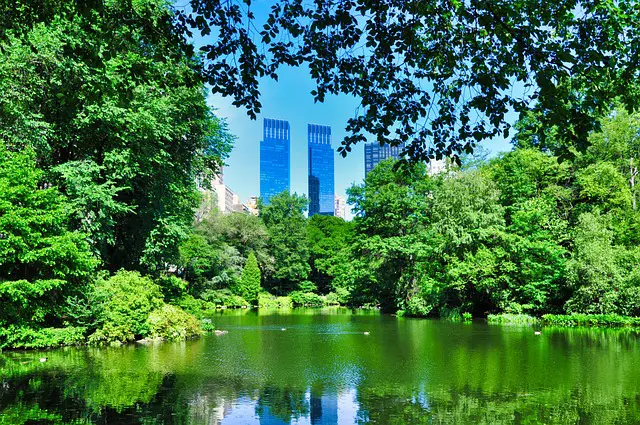
Restaurants and outdoor recreation
Central Park also has two indoor restaurants for visitors. Activities include guided tours (sometimes in horse-drawn carriages) and recreation (including two ice skating rinks, 26 baseball fields, and numerous pathways for joggers and runners).
The park is also a frequent site for concerts and live performances. Each summer, there is a multitude of events taking place for the tourists in the park. Central Park’s size has served as a model for many urban parks around the world.
It was also placed on UNESCO’s list of tentative World Heritage Sites in 2017.
Why is Central Park famous?
Central Park is famous for being one of the first major urban parks in the United States and a model for city parks worldwide. It’s known for its size, scenic beauty, and cultural importance in New York City.
Where is Central Park located in New York City?
Central Park is located in Manhattan, stretching from 59th Street to 110th Street, and between Fifth Avenue and Central Park West, dividing the Upper East Side and Upper West Side.
Who designed Central Park?
Central Park was designed by Frederick Law Olmsted and Calvert Vaux, who won a design competition in 1857 with their “Greensward Plan.” The park opened in stages and was largely completed by the 1870s.
What can you do in Central Park?
Visitors can walk, bike, boat, picnic, visit the Central Park Zoo, row on the lake, explore historic statues and architecture, or attend live performances like Shakespeare in the Park.
Is Central Park a National Historic Landmark?
Yes, Central Park was designated a National Historic Landmark in 1963 due to its historical, architectural, and cultural importance.
- Famous American Buildings
- Capitol Building
- Central Park New York
- Chrysler Building
- Empire State Building
- Flatiron Building
- Golden Gate Bridge
- Grand Central Terminal
- Jefferson Memorial
- Lincoln Memorial
- Memorial Statues
- One World Trade Center
- Statue of Liberty
- Top 10 American Buildings
- Top 10 American Memorials
- Top 10 American Skyscrapers
- Wall Street
- Washington Monument
- Washington National Cathedral
- White House
- Willis Tower